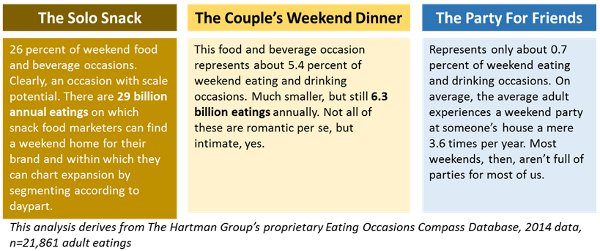Weekends Are Made for Marketers. Here’s the Real Potential of Party Occasions
 Forgetting (for a moment) pop culture foodie tidbits like the 2015 Green Bay Packers Tailgate Tour or Grill It! (with Bobby Flay), let’s reflect a little on a bygone era of eating and drinking, lamented in articles like a 2012 New York Times piece titled “Guess Who Isn’t Coming to Dinner” when socializing as a high art form took shape in the form of cocktail or dinner parties hosted in glamorous Hollywood or New York City settings. Everyday consumers, who likely aimed to host their own parties on weekends, took their cues from the society columns of newspapers, reading about “great hostesses” like Louise Grunwald, who commented in 2012, “It’s over. You may want the dinner party to come back, harkening back to another era. But it will never happen.”
Forgetting (for a moment) pop culture foodie tidbits like the 2015 Green Bay Packers Tailgate Tour or Grill It! (with Bobby Flay), let’s reflect a little on a bygone era of eating and drinking, lamented in articles like a 2012 New York Times piece titled “Guess Who Isn’t Coming to Dinner” when socializing as a high art form took shape in the form of cocktail or dinner parties hosted in glamorous Hollywood or New York City settings. Everyday consumers, who likely aimed to host their own parties on weekends, took their cues from the society columns of newspapers, reading about “great hostesses” like Louise Grunwald, who commented in 2012, “It’s over. You may want the dinner party to come back, harkening back to another era. But it will never happen.”
In many ways, she’s right: elaborate parties thrown on weekends seem to have gone the way of Jay Gatsby—culturally, we’re aware of such occasions, but socially many prefer to barbecue, tailgate, eat out or have a solo snack or a “couples weekend” dinner at home. This doesn’t mean hosting parties is dead; it just means that how we celebrate, socialize and entertain on weekends has shifted. Importantly, we find that for anyone undertaking occasion-based marketing of early-stage brands with low awareness, focusing on party occasions is a powerful tool for not only topline growth but also brand building.
Weekends: Rare Occasions for Brand Building and Driving Scale
In careful ethnographic research on food and beverage occasions, one of the key techniques available is eliciting narratives about recent eating and drinking experiences that consumers find most enjoyable. Inevitably, when we prompt for these kinds of gustatory tales, we hear stories of group food and beverage occasions (by group, we mean family or friends and rarely colleagues). But the word ‘group’ is a bit dry.
In reality, these are stories about parties and celebrations, large and small, either when friends come over to catch up over the backyard grill or when they go eat out at a cool new restaurant. When we take these high-intensity narratives and measure their absolute empirical frequency, we find something very intriguing. We love to talk most about eating events that are unique and rare. In fact, their very rarity is connected to not only who is attending but also to the high level of intention and discrimination in the selection of what and how they eat (and drink).
High stakes, rarity and pickiness seem to go hand in hand in modern eating culture when it comes to celebrations. What does this mean for marketers trying to devise occasion-based advertising and promotions? It means that which occasion you target needs to be carefully thought through based on your most pressing financial and strategic goals. Do you seek new sources of scale through nudging the consumer to your brand on a new occasion or do you want to heighten the perceived value of your brand by making it seem worthy of being consumed on a high-stakes, but rare, occasion?
Let’s look at the universe of American weekend eating and drinking to see how this might play out.
Below are three culturally salient eating occasions that transpire on the American weekend (Friday night through Sunday evening):

If you’re a beer or wine maker, the small incidence of weekend parties in America might not concern you, because your category is unusually tied to serving this occasion alone. For you, it is your scale occasion. Specifically, although defending scale and share is the primary reason for marketing beer to parties directly, ironically, the one thing large legacy beer manufacturers understand well is that infrequent occasions have a very powerful branding function in consumers’ social lives.
- The rarity of the occasion makes a good product highly likely to be remembered and subsequently discussed post-event, much more so than the random fridge scavenging snack on Saturday afternoon (even if it was a good snack)
- Consumers almost always have some leftover product, which then carries an emotional halo of that ‘party’ purchase onto ordinary, much more frequent, purchase and use occasions. This serves as an important form of pantry advertising that can either a) sustain or b) initiate brand purchases in the category for ordinary weekday occasions
In fact, for anyone trying to do occasion-based PR or marketing of early-stage (i.e., young) brands with low awareness, using party occasions as a portal is a powerful tool for not only topline growth but also brand building. You want your new product to be introduced to new consumers on an occasion when the social structure of the occasion itself is encouraging them to try something new.
Parties are examples of how rare occasions are highly suited to new product introduction and the building of new brands around innovative products. These are the heightened cultural moments when consumers are most likely to be open to new flavors and experiences, at least to try them. After all, it costs them nothing to do so. The backyard BBQ and the dinner party constitute marketers’ most effective sampling program and one that actually pays for itself.
The lesson here is that just because an occasion has low incidence that does not mean it is not useful strategically: as Michelob so cleverly hinted at in its ads, weekends are indeed made for marketers. Since the home is the site where many high-value, low-incidence occasions transpire right before or after low-value, high-incidence ones, the ability to use high-value occasions like parties as a portal to the home in a competitive marketplace will yield a new product or brand much greater share of mind and influence than targeting scale-oriented occasions.
